Phase, Chemical, Thermal, and Morphological Analyses of Thermoplastic Polyurethane (TPU) Nanocomposites Reinforced with Jute Cellulose Nanofibers (CNFs)
Abstract
1. Introduction
2. Materials and Methods
2.1. Preparation of CNFs from Jute Fiber
2.2. Preparation of TPU Nanocomposite
2.3. Fourier Transform Infrared (FTIR) Spectroscopy
2.4. X-Ray Diffraction (XRD)
3. Results and Discussion
3.1. Phase Analysis of Initial TPU and TPU/Jute CNF Nanocomposites by XRD
3.2. FTIR Analysis of Initial TPU and TPU/Jute CNF Nanocomposites
3.3. Field Emission Scanning Electron Microscopy (FESEM) Analysis of Initial TPU and TPU/Jute CNF Nanocomposites
3.4. Thermal Analysis
3.4.1. Differential Scanning Calorimetry (DSC) Analysis of Initial TPU and TPU/Jute CNF Nanocomposites
3.4.2. Thermogravimetric Analysis of Initial TPU and TPU/Jute CNF Nanocomposites
4. Conclusions
Author Contributions
Funding
Data Availability Statement
Conflicts of Interest
References
- Shen, J.; Liang, J.; Lin, X.; Lin, H.; Yu, J.; Yang, Z. Recent Progress in Polymer-Based Building Materials. Int. J. Polym. Sci. 2020, 2020, 8838160. [Google Scholar] [CrossRef]
- Joseph, P.G. 12-Polymer Composites, Plastic Design Library. In Automotive Plastics and Composites; William Andrew Publishing: Norwich, NY, USA, 2021; pp. 191–222. [Google Scholar] [CrossRef]
- Siti Syazwani, N.; Ervina, E.M.N.; Kok, C.K.; Aeslina, A.K.; Sivaraman, V. Microstructure and Mechanical Properties of Thermoplastic Polyurethane/Jute Cellulose Nanofibers (CNFs) Nanocomposites. In Recent Trends in Manufacturing and Materials Towards Industry 4.0: Lecture Notes in Mechanical Engineering; Springer: Singapore, 2021; pp. 805–816. [Google Scholar] [CrossRef]
- Pandey, V.C.; Mahajan, P.; Saikia, P.; Praveen, A. Chapter 7: Multipurpose Uses of Fiber Crops-Societal, Economic and Environmental Development. In Fiber Crop-Based Phytoremediation: Socio-Economic and Environmental Sustainability; Elsevier: Amsterdam, The Netherlands, 2022; pp. 181–229. [Google Scholar] [CrossRef]
- Haghighatnia, T.; Abbasian, A.; Morshdian, J. Hemp Fiber Reinforced Thermoplastic Polyurethane Composite: An Investigation in Mechanical Properties. Ind. Crops Prod. 2017, 208, 853–863. [Google Scholar] [CrossRef]
- Siti Syazwani, N.; Ervina, E.M.M.; Kok, C.K.; Nurhidayatullaili, M.J. Synthesis of Cellulose Nanofibers from Jute Fiber by Using Chemomechanical Method. F1000 Res. 2024, 13, 40. [Google Scholar]
- Islam, M.H.; Islam, M.R.; Dulal, M.; Afroj, S.; Karim, N. The effect of surface treatments and graphene-based modifications on mechanical properties of natural jute fiber composites: A review. iScience 2022, 25, 103597. [Google Scholar] [CrossRef] [PubMed]
- Karim, N.; Sarker, F.; Afroj, S.; Zhang, M.; Potluri, P.; Novoselov, K.S. Sustainable and multifunctional composites of graphene-based natural jute fibers. Adv. Sustain. Syst. 2021, 5, 2000228. [Google Scholar] [CrossRef]
- Rangasamy, G.; Mani, S.; Kolandavelu, S.K.S.; Alsoufi, M.S.; Ibrahim, A.M.M.; Muthusamy, S.; Panchal, H.; Sadasivuni, K.K.; Elsheikh, A.H. An extensive analysis of mechanical, thermal and physical properties of jute fiber composites with different fiber orientations. Case Stud. Therm. Eng. 2021, 28, 101612. [Google Scholar] [CrossRef]
- Ervina, E.M.N.; Siti Syazwani, N. A Review on Effect of Nanoreinforcement on Mechanical Properties of Polymer Nanocomposites. Solid State Phenom. 2018, 280, 284–293. [Google Scholar] [CrossRef]
- Haq, E.; Saifullah, A.; Azim, A.Y.M.A.; Alimizzaman, S.; Dhakal, H.N.; Sarker, F. Improved Mechanical Properties of Environmentally Friendly Jute Fibre Reinforced Metal Laminate Sandwich Composite Through Enhanced Interface. Heliyon 2024, 10, e24345. [Google Scholar] [CrossRef] [PubMed]
- Sailesh, A.; Palanikumar, K.; Mani, N.; Ponshanmugakumar, A. A Review on the Sustainability Prospects of Bio Fibre Reinforced Composite Materials. In Composites Science and Technology: Bio-Fiber Reinforced Composite Materials; Springer: Singapore, 2022; pp. 361–374. [Google Scholar] [CrossRef]
- Syazwani, N.S.; Efzan, M.E.; Kok, C.K.; Nurhidayatullaili, M.J. Analysis on extracted jute cellulose nanofibers by Fourier transform infrared and X-ray diffraction. J. Build. Eng. 2022, 48, 103744. [Google Scholar] [CrossRef]
- Kumar, R.; Kumari, S.; Rai, B.; Das, R.; Kumar, G. Effect of nano-cellulosic fiber on mechanical and barrier properties of polylactic acid (PLA) green nanocomposite film. Mater. Res. Express 2019, 6, 125108. [Google Scholar] [CrossRef]
- Adin, H.; Adin, M.Ş. Effect of particles on tensile and bending properties of jute epoxy composites. Mater. Test. 2022, 64, 401–411. [Google Scholar] [CrossRef]
- Kim, Y.; Huh, P.; Yoo, S.I. Mechanical Reinforcement of Thermoplastic Polyurethane Nanocomposites by Surface-Modified Nanocellulose. Macromol. Chem. Phys. 2023, 224, 2200383. [Google Scholar] [CrossRef]
- Li, X.; Li, J.; Wang, J.; Yuan, J.; Jiang, F.; Yu, X.; Xiao, F. Recent applications and developments of polyurethane materials in pavement engineering. Constr. Build. Mater. 2021, 304, 124639. [Google Scholar] [CrossRef]
- Thiyagu, C.; Manjubala, I.; Narendrakumar, U. Thermal and morphological study of graphene based polyurethane composites. Mater. Today Proc. 2020, 45, 3982–3985. [Google Scholar] [CrossRef]
- Mohamed, A.A.; Bachtiar, D.; Siregar, J.P.; Rejab, M.R.M. Effect of sodium hydroxide on the tensile properties of sugar palm fibre reinforced thermoplastic polyurethane composites. J. Mech. Eng. Sci. 2016, 10, 1765–1777. [Google Scholar] [CrossRef]
- Li, C.; Li, R.; Lyu, P.; Wang, Y.; Zhang, C.; Dai, F.; Xin, L. The fabrication of thermoplastic polyurethane/leather powder composite film with excellent mechanical property. Compos. Commun. 2021, 25, 100694. [Google Scholar] [CrossRef]
- Mistry, P.; Chhabra, R.; Muke, S.; Sathaye, S.; Jain, R.; Dandekar, P. Fabrication and characterization of starch-TPU based nanofibers for wound healing applications. Mater. Sci. Eng. C 2020, 119, 111316. [Google Scholar] [CrossRef] [PubMed]
- ASTM D638-14; Standard Test Method for Tensile Properties of Plastics. ASTM International: West Conshohocken, PA, USA, 2014.
- Puszka, A.; Kultys, A. The influence of soft segments on some properties of new transparent segmented polyurethanes. Polym. Adv. Technol. 2017, 28, 1–8. [Google Scholar] [CrossRef]
- Belarbi, A.; Dawood, M.; Acun, B. Sustainability of fiber-reinforced polymers (FRPs) as a construction material. In Sustainability of Construction Materials; Woodhead Publishing: Sawston, UK, 2016; pp. 521–538. [Google Scholar] [CrossRef]
- Kowalski, M.; Kowalska, K.; Wiszniowski, J. Qualitative analysis of activated sludge using FT-IR technique. Chem. Pap. 2018, 72, 2699–2706. [Google Scholar] [CrossRef] [PubMed]
- Clark, C.J.; Bureau, S.; Cozzolino, D. Contributions of Fourier-transform mid-infrared (FT-MIR) spectroscopy to the study of fruit and vegetables: A review. Postharvest Biol. Technol. 2020, 148, 1–14. [Google Scholar] [CrossRef]
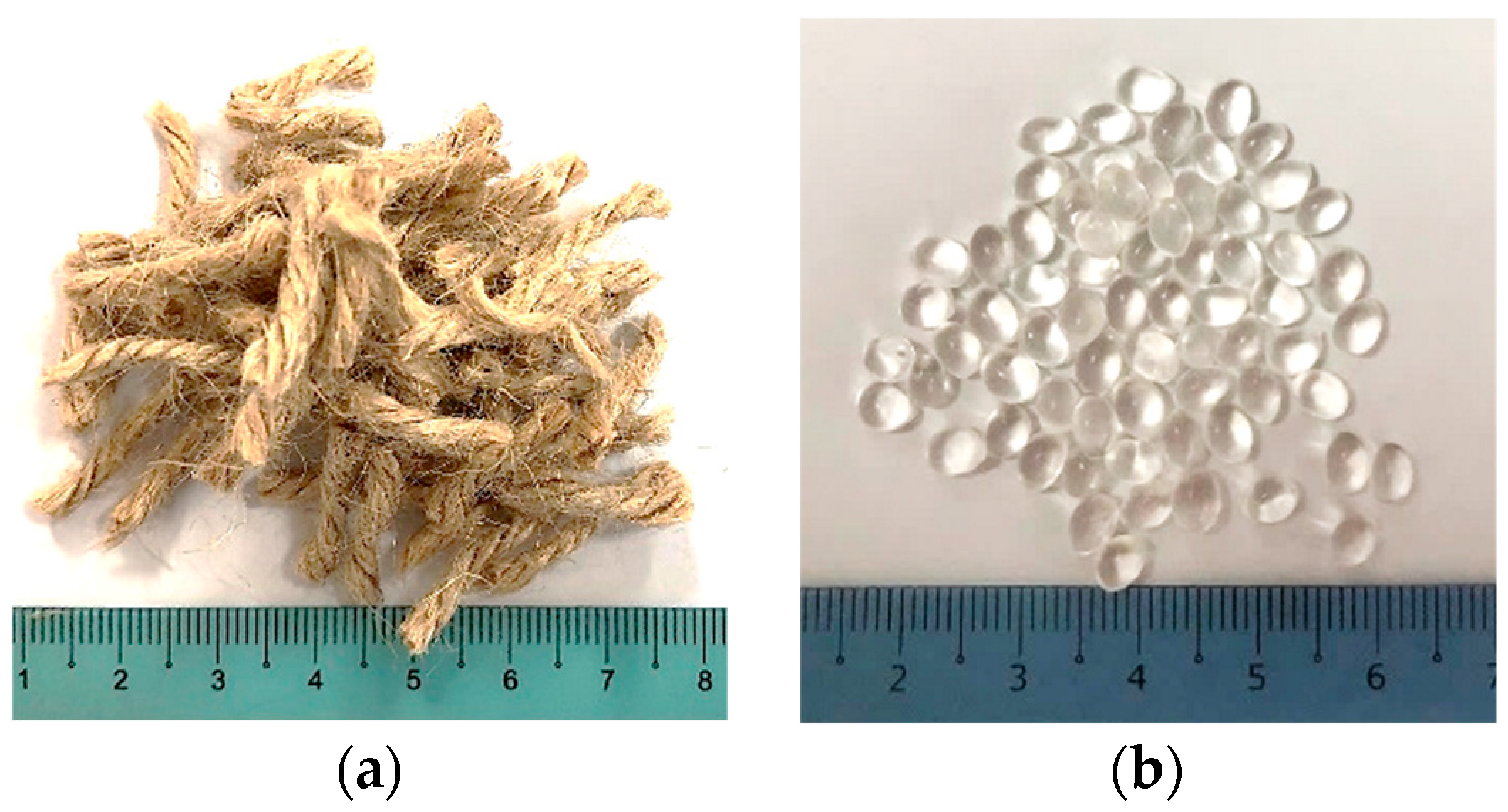

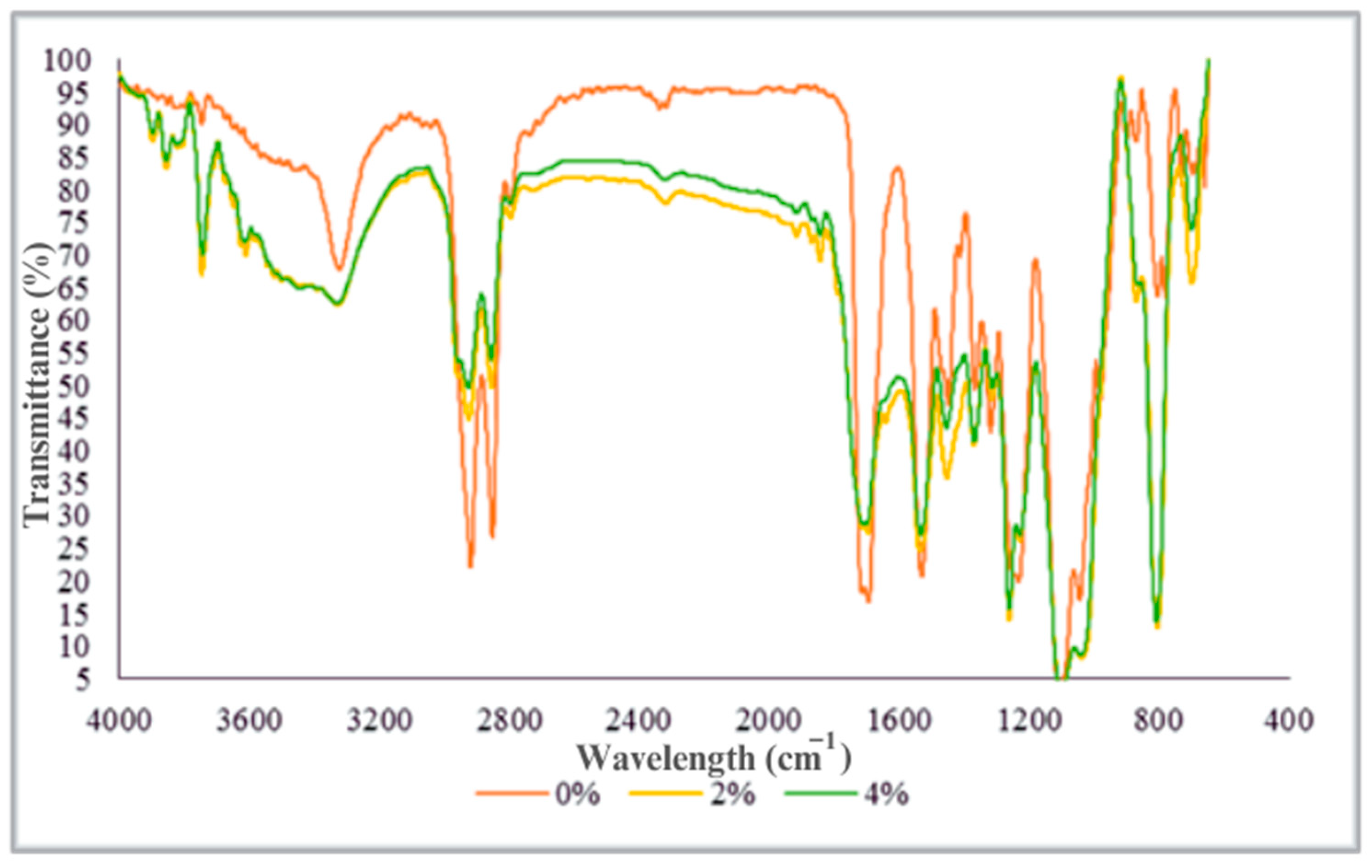

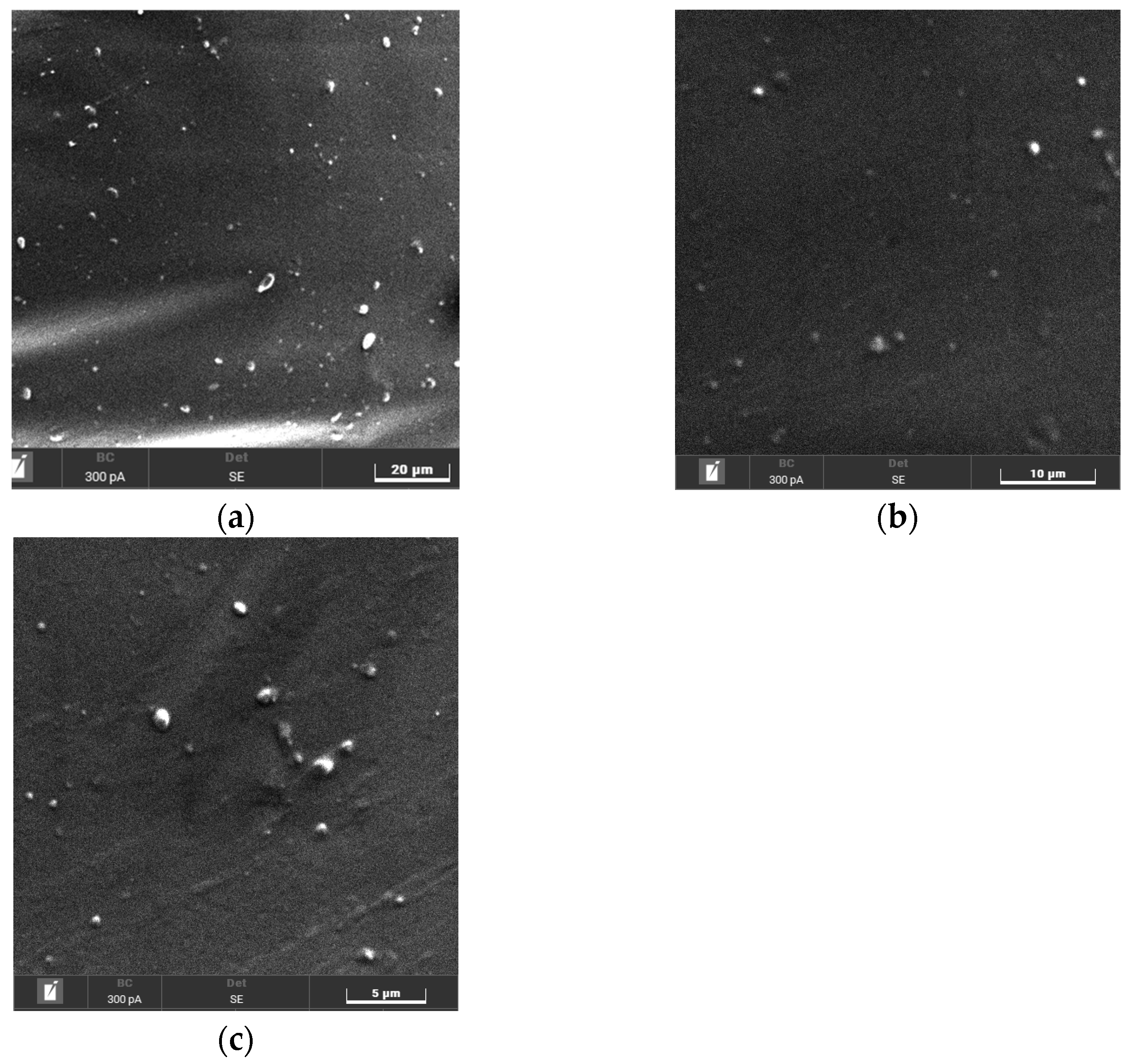

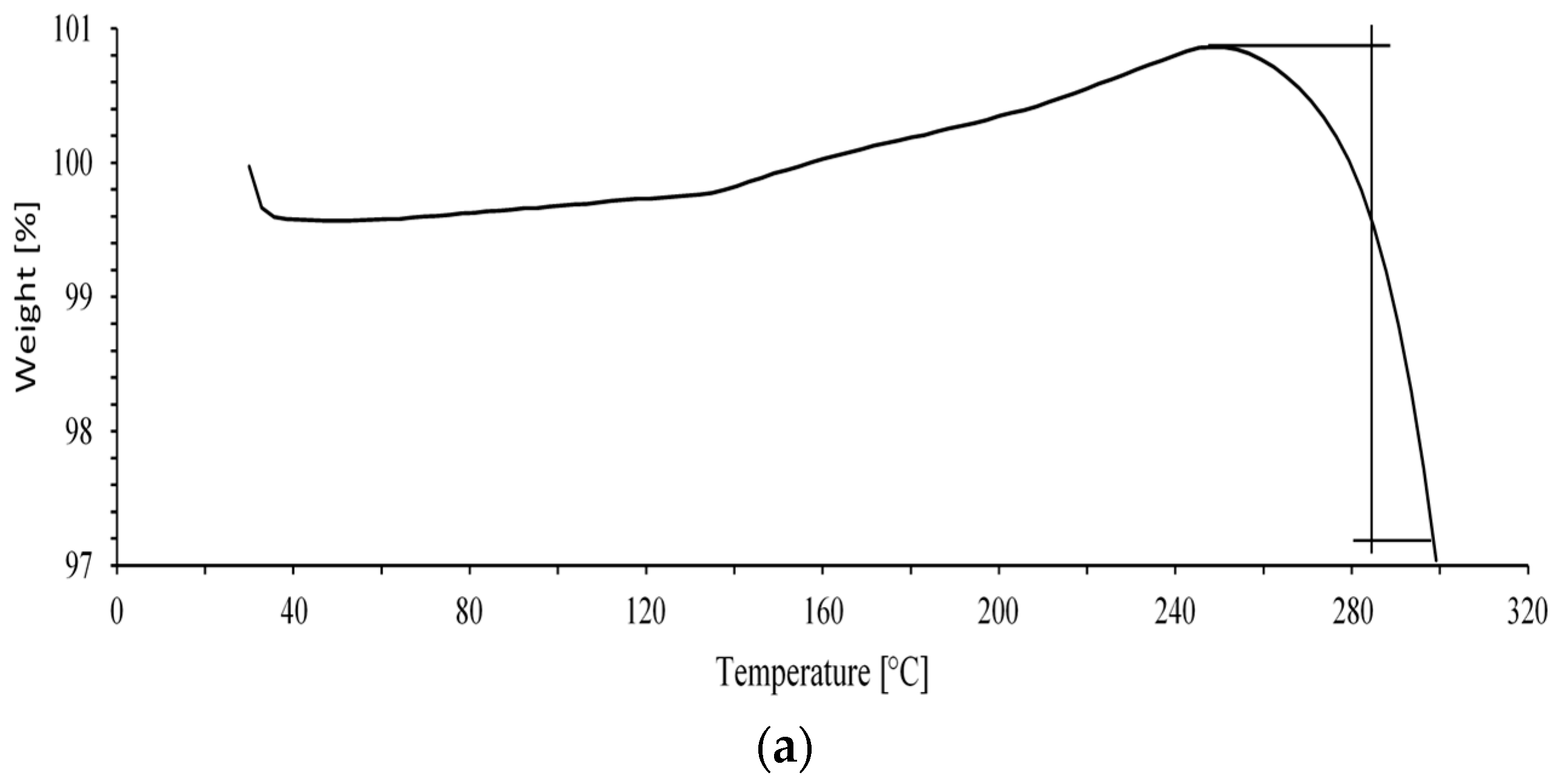
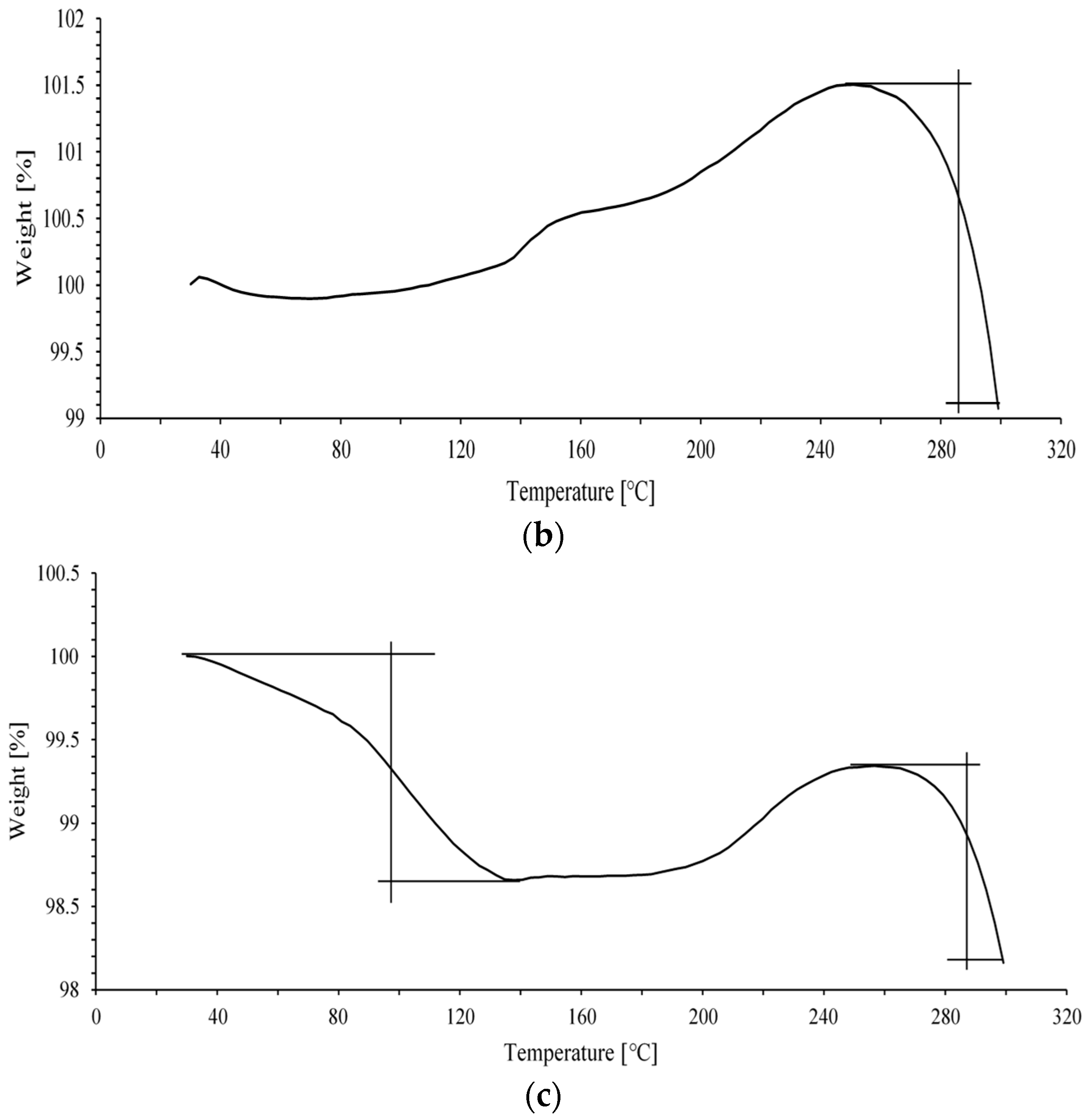
Disclaimer/Publisher’s Note: The statements, opinions and data contained in all publications are solely those of the individual author(s) and contributor(s) and not of MDPI and/or the editor(s). MDPI and/or the editor(s) disclaim responsibility for any injury to people or property resulting from any ideas, methods, instructions or products referred to in the content. |
© 2025 by the authors. Licensee MDPI, Basel, Switzerland. This article is an open access article distributed under the terms and conditions of the Creative Commons Attribution (CC BY) license (https://creativecommons.org/licenses/by/4.0/).
Share and Cite
Nordi, S.S.; Noor, E.E.M.; Kok, C.K.; Julkapli, N.M.; Baig, M.F. Phase, Chemical, Thermal, and Morphological Analyses of Thermoplastic Polyurethane (TPU) Nanocomposites Reinforced with Jute Cellulose Nanofibers (CNFs). Polymers 2025, 17, 899. https://doi.org/10.3390/polym17070899
Nordi SS, Noor EEM, Kok CK, Julkapli NM, Baig MF. Phase, Chemical, Thermal, and Morphological Analyses of Thermoplastic Polyurethane (TPU) Nanocomposites Reinforced with Jute Cellulose Nanofibers (CNFs). Polymers. 2025; 17(7):899. https://doi.org/10.3390/polym17070899
Chicago/Turabian StyleNordi, Siti Syazwani, Ervina Efzan Mhd Noor, Chee Kuang Kok, Nurhidayatullaili Muhd Julkapli, and Mirza Farrukh Baig. 2025. "Phase, Chemical, Thermal, and Morphological Analyses of Thermoplastic Polyurethane (TPU) Nanocomposites Reinforced with Jute Cellulose Nanofibers (CNFs)" Polymers 17, no. 7: 899. https://doi.org/10.3390/polym17070899
APA StyleNordi, S. S., Noor, E. E. M., Kok, C. K., Julkapli, N. M., & Baig, M. F. (2025). Phase, Chemical, Thermal, and Morphological Analyses of Thermoplastic Polyurethane (TPU) Nanocomposites Reinforced with Jute Cellulose Nanofibers (CNFs). Polymers, 17(7), 899. https://doi.org/10.3390/polym17070899





